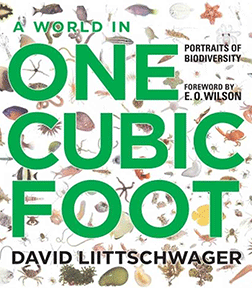By David L. Kirchman
The cubic foot of this book’s title was set by a green frame put out by photographer David Liittschwager into six environments, from Duck River, Tennessee to Mountain Fynbos, South Africa. He then recorded the flora and fauna that happened to be there or to pass through the cube or to knock it askew as in the case of a raccoon in Central Park of New York City. Aside from the raccoon and the pups of a California sea lion and a Pacific harbor seal in San Francisco Bay, the subjects photographed by Liittschwager were small, most much smaller than a foot, nearly all likely to go unnoticed even by the most ardent nature lover. To use a phrase from E.O. Wilson, the Harvard naturalist and author of the book’s foreword, Liittschwager takes us on a Magellanic voyage in worlds we unthinkingly step on or over.
The book magically brings out the beauty and wonder and often the weirdness of the minute denizens of these Lilliputian worlds. The first few pages have a shot of an ant that is about a half inch long in nature, nearly a foot in the picture. A picture that big is possible because the book itself is one foot by one foot, although fortunately only an inch or so thick. An inch-tall skeleton shrimp is menacing and alien-like in its nearly foot high portrait. A picture taking up an entire page illustrates how the half-inch wide seed of a burio tree in Monteverde, Costa Rica, uses its barbed spines to sink into a passerby and hitch a ride to new habitats. Those pups of San Francisco Bay are more cuddly than the inch-long ten-spotted ground beetle of Mountain Fynbos, but not more intriguing. Slugs are still slugs even if magnified five-fold, but the leopard slug in its foot-high portrait sort of has the sleekness of its feline namesake. Only in a large format picture can we appreciate the diaphanous wings, cobalt thorax, and bulging eyes of the blue-ringed dancer.
Each animal (or a part of a few plants) is depicted on a single, white page, usually starkly alone without any adornment, aside from a caption with the organism’s size and name, both common and scientific. Many of the pictures seem more at home in a fashion magazine than in a naturalist’s field guide, perhaps reflecting Liittschwager’s stint as an assistant for Richard Avedon in New York. The focus on the subject, not the environment, is necessary in many cases. Some of these animals would be too camouflaged to appreciate in a more natural setting. We can admire the shine and tight coils of the quarter inch pillbug, rolled up in a ball on the blank page, but it would be just another lump of dirt if photographed in its habitat. The photographs that begin each chapter show the green frame in the featured environment, but even those pictures have an otherworldly feel, perhaps befitting the strangeness of many of the organisms captured in Liittschwager’s cubic foot.
Preceding the portrait gallery of each chapter is a short essay inspired by the chapter’s environment. These are written by an eclectic mix of people, from poets to scientists. Perhaps most famous (at least to The New Yorker readers) is Elizabeth Kolbert who used her piece about the coral reefs off Moorea, an island near Tahiti, to comment on how global warming and changing ocean chemistry threaten corals worldwide. For the San Francisco Bay chapter, August Kleinzahler begins with quotes from The Diamond Sutra and other Buddhist sources, and muses about the number of stars in the Milky Way and of planktonic organisms passing under the Golden State Bridge. Jasper and Peter Slingsby, son and father, dive into the intricate ecological relationships between some ants and plants and discuss the impact of fires on Mountain Fynbos.
The book’s foreword from Wilson is also a mixture of poetry and science, touching on themes of both wonder and environmental stewardship. Wilson alludes to the importance of small organisms and miniature ecosystems in holding our biosphere together, and marvels at the diversity of tiny oribatid mites with spider and turtle features, numbering in the thousands in a cubic foot of soil. Yet it is doubtful that these mites and beetles and slugs will take on the status of the spotted owl and help to preserve the environments covered by Liittschwager’s book. A more modest hope is that readers of the book will appreciate the diversity of life on our planet and the beauty of overlooked worlds.
David L. Kirchman (ΦBK, Lawrence University, 1976) is the Maxwell P. and Mildred H. Harrington Professor Marine Biosciences at the University of Delaware and a resident member of the Alpha of Delaware chapter of Phi Beta Kappa.




